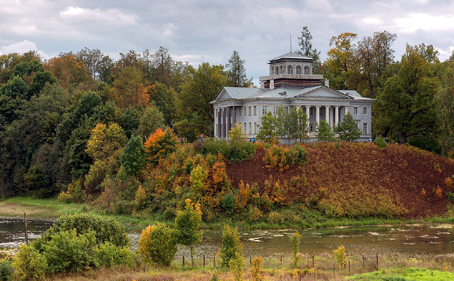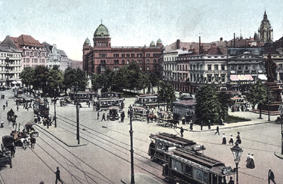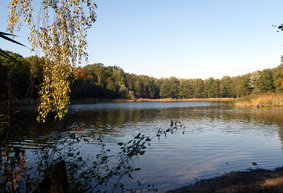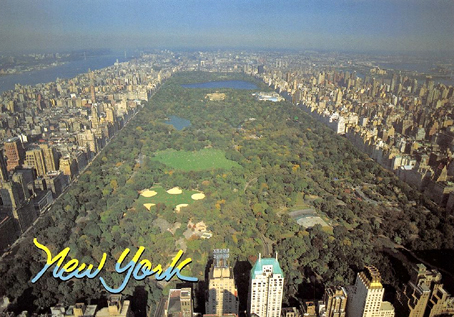Nabokov's Whereabouts
by Dieter E. Zimmer
December 2018 -- July 2019
This has been a list-in-progress ever since its inception in the early 1990s, when I began it as one of the tools needed for editing Nabokov's Collected Works in German (Gesammelte Werke, Rowohlt Verlag, 25 volumes from 1989 to 2017). Since 1997 its various early stages were published on Jeff Edmund's website Zembla "frozen" in 2015. The last addition there was made in 2004; all further additions and corrections are collected on this webpage. Most of the addresses have been culled from Brian Boyd's stupendous two-volume biography, others from Nabokov's memoir Speak, Memory and from his published letters, some from Stacy Schiff's Véra and from Nabokov's Letters to Véra, from my own book on Nabokovs Berlin and from various gazetteers of the time. Without the Internet with its boundless possibilities of checking localities and finding historical picture post cards and without the Satellite and Street View images furnished by Google Maps and Google Earth, the illustrations would be much scantier.
1899
Vladimir Nabokov was born on April 10, 1899 (Old Style, i.e. under the Julian calendar). According to his own calculation, this would correspond to April 23 in the Gregorian calendar (New Style) which Russia introduced in 1918. However, the calculation is tricky because on Nabokov's first birthday the turn of the century had intervened: On February 17, 1900 the advance of the Gregorian calendar increased from twelve to thirteen days. So add twelve or thirteen days? The critical date is the date of birth and not the first birthday. So for his year of birth, twelve days should be added. The N.S. birthday that would be generally agreed on would be April 22.
Nabokov spends his infancy and childhood at the townhouse of his family on Bolshaya Morskaya Street 47, St. Petersburg, Russia, in the noble center of the town, just a few hundred metres from St. Isaac's Square. The long summers of his childhood and youth he either spends at his family's country estate of Vyra, c. 75 km south of St. Petersburg, or traveling with his family to Austria (Opatija), France (Côte d'Azur and Biarritz) or Germany (Wiesbaden, Bad Kissingen, Berlin). His first-hand knowledge of what was Russia will be confined to St. Petersburg and the region immediately south of it, with the exception of a summer month in 1911 passed on the second estate of his Sayn-Wittgenstein relatives, Camenca in the province that was called Podolia in Tsarist Russia and is Transnistria today.
|
|
|
|
_MIN.jpg) |
|
»Morskaya 47 |
|
»The staircase |
»The
bay window ©DEZ 1990 |
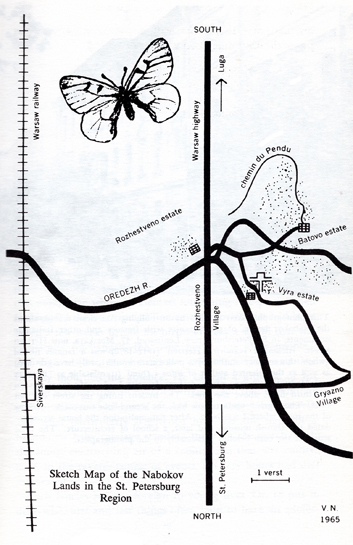
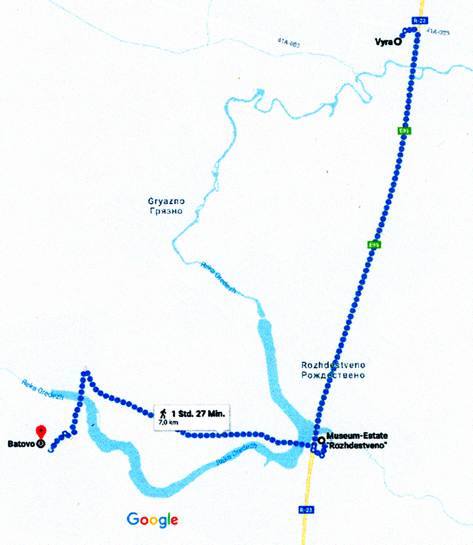
|
|
For the expanded version of his memoir
Speak, Memory
(1966), Nabokov from memory drew a simple diagram map of the region
he knew best: Vyra, Rozhdestveno and Batovo south of St. Petersburg,
what he called "the Nabokov Lands" (»left). Strangely, this
map is misleading or downright wrong in several respects. First of
all, you have to mirror it twice to make it resemble a normal map
like the one from Google Maps (»right),
making the upper end South and the right side West (»mirrored
map for comparison). But after this
major operation, a few glitches still remain. The black ribbon Nabokov
names Oredezh R. is not the Oredezh at all. The Oredezh, coming from
the west, flows past Batovo towards Rozhdestveno, reaches the main
north-to-south highway (today E95, Kiyevskoye Shosse) opposite
the Rozhdestveno mansion but does not cross it. Instead it turns
sharp left in
northwesterly direction towards Gryazno, then winds its way north and then
again east, skirting Vyra just before finally crossing E95 and
continuing towards Siverski and its train station. What
Nabokov's map explicitly calls Oredezh is only a small tributary
called Gryazno River, a sort of appendix that skirts the Rozhdestveno
mansion, crosses E95
and immediately flows into the Oredezh. According to the scale of
Nabokov's map, the distance from Vyra estate to Rozhdestveno
mansion is only 2 verst (1 verst = 1,067 km); actually it is twice as far, 4,3 km. From Vyra to
Batovo it is not just over 2 km as it is on VN's map but 7 km along
the highway E95 or 5 km on backroads by way of Gryazno. That is, the
three estates do not form "three linked rings in a ten mile chain"
as VN wrote; the "chain" is only 7.5 miles long and has the
shape of an elongated triangle with Vyra in the north
and Batovo and Rozdestveno as a southern base. |
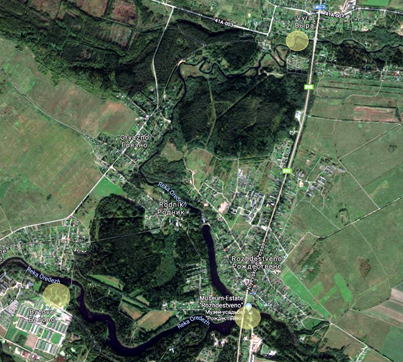
»"The Nabokov Lands" as seen from a satelllite. Vyra, Batovo and Rozhdestveno are marked yellow. Source: Google Satellite 2018 |
1903
(September) With his family to Paris and to Nice.
1904
(Early summer) Family travels to Paris and Beaulieu (staying at Hotel Bristol).
1905
(Early) Return to St. Petersburg.
|
|
|
»Villa Neptun, Abbazia (today
Opatija) |
(Summer) Travel to Abbazia, Austria-Hungary (today Opatija, Croatia), where they stay at Villa Neptun or Villa Apollo, occupied by Ivan de Peterson, a relative.
Later that year they travel on to Wiesbaden where they stay at Hotel Oranien, Platter Strasse 2, for several months.
|
|
| »Hotel Oranien, Wiesbaden Source: Hotel Web publicity |
(Autumn and winter) Because of the rioting in St. Petersburg, the family remains at their estate of Vyra.
(End of year, in the middle of the St. Petersburg winter) Arrival of governess Cécile Miauton ("Mademoiselle") from Lausanne, Switzerland. She is picked up at the train station of Siverski.
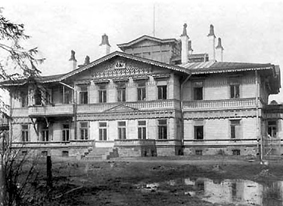 |
_MIN.jpg) |
| »The
mansion of the estate of Vyra Source: Culture of the Leningrad Oblast |
»Oredezh
River near Rozhdestveno Photo: ©DEZ 1990 |
1906-1907
(Autumn) The family moves to a first floor apartment at Sergievskaya Street 38 (today Chaikovskogo Street 38) near Taurid Garden for a year, to get away from Mariinskaya Square, the place of bloodshed during the 1905 uprising; the house (then dove-blue, today yellow) Nabokov later gave to the red-haired young aunt who introduces Luzhin to chess (in his novel The Defense).
_MIN.jpg) |
|
»Chaikovskogo
Street
38 Photo: ©DEZ 1997 |
1907
(August) On the Nord-Express via Berlin and Paris with family to Biarritz where they stay at a rented apartment.
_MIN.jpg) |
|
»The Nord-Express
(St.Petersburg-Berlin-Paris) at the East-Prussian border station of Eydtkuhnen PPC c. 1907, Sammlung Gottwaldt |
1909
(Autumn)
Another trip to Biarritz
with a party of twelve where they
rent
a villa
for two months. Shy but
intense flirtation with nine-year-old Claude Deprès, the "Colette" of
VN's memoir
Speak, Memory.
_MIN.jpg) |
| »Biarritz, Grande Plage and Casino Col. PPC before WWI |
1910
(August to January 1911) With family to Bad Kissingen, Germany, and then with tutor Filip Zelenski ("Lenski") for three months to Berlin, first at Hotel Adlon, Unter den Linden 1, then at a "pension moderne" on Privatstrasse (today Bissingzeile), a lane off Potsdamer Strasse near Potsdamer Brücke, to get his teeth fixed by the American "orthodontist" Dr. W. G. Law (remembered by Nabokov as "Lowen" or "Lowell") on In den Zelten 18a, Berlin-Tiergarten (today site of the Federal Chancellery).
_MIN.jpg) |
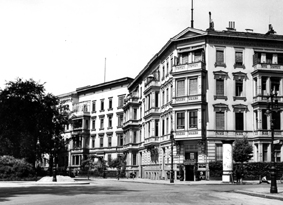 |
|
»Where
Nabokov went rollerskating |
»Where
his dentist practised |
1911
(August)
Elena Nabokov and
her children spend
a month
with her sister-in-law Elizaveta Sayn-Wittgenstein
at
Camenca
(Russian spelling Kamenka), the
Sayn-Wittgenstein estate
on the left (Eastern) bank of the Dnister River
in
what in Tsarist Russia was the Province of Podolia, about one thousand miles
straight south of St. Petersburg. Today it is in the north of Transnistria,
a disputed region lying between Moldova and SW Ukraine. Transnistria has
proclaimed itself independent of Moldova after the breakup of the Soviet
Union, but de jure still is part of it. Camenca is the Romanian
name, the offical language of Transnistria being that of Moldova and that of
Moldova being Romanian. Camenca was the second Sayn-Wittgenstein estate; the
first was Druzhnoselie c. 10 km NE of Vyra, near the train station of Siverski, which the Nabokovs
used to visit. The Estate of Camenca had been bought and developed by Antonina Wittgenstein
on behalf of her husband, Prince Pyotr
Wittgenstein, a field marshal of the Napoleonic wars whom Tolstoi (who
praised Camenca) in War
and Peace called "the Hero of St. Petersburg". After the
Bolshevist Revolution, with the current count Wittgenstein killed in
the prison of Winnyzja, the estate was expropriated and slowly developed into a city, home of the
famous Dnister Sanatorium the beginnings of which exist since Prince Pyotr's
time.
Nabokov was twelve on
this trip and seems to have had only a diffuse idea of where they were. In
Speak, Memory (p.61) he spoke of that "splendid estate, Kamenka, in
the Province of Podolsk, S.W. Russia"–which may lead one to place it roughly thirty miles
south of Moscow. Even Brian Boyd was misled (VNRY, p.96) and placed
'Kamenka' "near Popelyukha, in the province of Podolsk, southwest Russia–the only occasion before the revolution, it
seems, that Nabokov spent time in Russia other than in St. Petersburg or
around Vyra, and a rare chance for him to catch butterflies from a different
Russian fauna." By the way, Podolsk was no Province (Russian
Oblast, in German and French often rendered as Gouvernement) but
only a regional administrative center in the Province of Moscow.
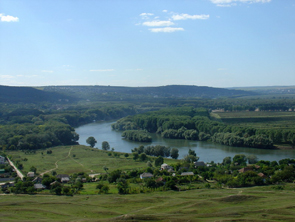 |
|
»Dnister River at
Camenca Source: https://KehilaLinks.jewishgen.org |
1911-1917
Attends Tenishev (High) School on Mokhovaya Street 33-35, St. Petersburg.
_MIN.jpg) |
|
»Tenishev
School on Mokhovaya Street PPC, Source: Wikimedia Commons |
1913
(Autumn) Nabokov's paternal grandmother
Baroness Maria Korff sells her estate, Batovo,
to a saw-mill
and moves to a townhouse in Gatchina.
The mansion at Batovo burns down in 1925.
Today Batovo is a poultry farm.
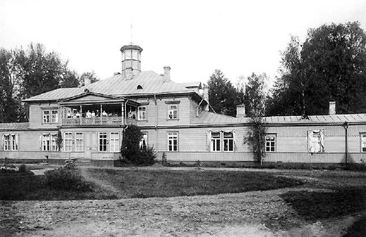
»Mansion
of Batovo Estate, around 1900
Source: Culture of the Leningrad Oblast
1914
In Speak, Memory, Nabokov tells he wrote his first poem ("Rain flew ...") in the summer of 1914, in the pavillon of the Old Park at Vyra. As Brian Boyd pointed out, "Rain flew" was actually written in 1917 when Nabokov had been composing verses for three years. In 1914 he had been writing other poems, all lost. "Rain flew" may not be the poem whose genesis he describes in Speak, Memory: the details do not accord.
1916
|
|
|
»Mansion
of Rozhdestveno Estate |
(Late autumn) 42 years old,
unexpectedly Nabokov's "Uncle Ruká" (Vasili Ivanovich Rukavishnikov),
who had mostly been living abroad, dies of
heart failure at Hospital Sainte-Maude (?) near Paris. He bequeathes to his
nephew his neo-classical wooden Mansion on the Estate of Rozhdestveno and the
vast surrounding parks and forests. The value of the property was estimated
at £2 million. A year later, the Bolshevist revolution
abolished everything before Nabokov had even had a chance to take it in
possession. Today, the building houses a "Museum-Estate" and is a tourist
site, with many Nabokov and Rukavishnikov memorabilia.
1917
(November 15 N.S.) To get away from revolutionary ongoings in St. Petersburg for a while and to avoid being drafted into the Red Army, Vladimir and his brother Sergey leave the city for Crimea, by the Simferopol Express via Moscow. Their father takes them to the Nikolaevski station to see them off and follows them a few weeks later.
_MIN.jpg) |
|
»The
Panin Palace at Gaspra, Crimea Source: Wikipedia |
(November 18 N.S.) Arrival on Crimea. Family friend and political colleague Countess Sofya Panin (not present at the time) had offered them to stay at the guest house of her palace at Gaspra, at the foot of Mt. Ai-Petri (1234 m) which Nabokov is to climb. The Panin palace becomes a lively cultural center for artists that were fleeing from the Bolshevist coup d'état.
Nabokov translates several Heine poems for a concert of Schubert and Schumann lieder by singer Anna Yan-Ruban at a neighboring home.
1918
(Summer) Spends some time at the nearby domain Oleiz between Gaspra and Koreiz with Lidiya Tokmakov.
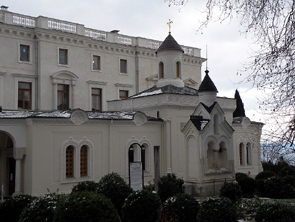 |
|
»Livadiya,
Palace Chapel, Yalta - the former Imperial summer domain Photo: KGGucwa, 2008, Wikimedia Commons |
(Late September) The family moves to the second floor of the choristers' chapel of the former Imperial summer domain of Livadiya 3 km W of Yalta (where in February, 1945 the Yalta Conference between Stalin, Roosevelt and Churchill was to take place).
1919
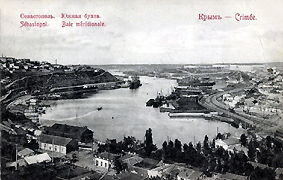 |
| »Sebastopol, Crimea - Port PPC c.1913 |
(April 15) Shortly before the south of Crimea falls to the Reds, the family leaves Sevastopol for Constantinople and then on to Piraeus, Greece, on the Greek vessel S.S. 'Nadezhda' (Hope).
In Piraeus, all three families of Nabokovs who had landed here
moved along the shoreline away from dingy coal freighters and minesweepers
and past gleaming yachts to the white hotels of Phaleron, the smart seaside
suburb of Athens. For the next few weeks V. D. Nabokov and his family,
though desperately short of money, stayed at the Hotel Neon Phaleron—three
stars in Nabokov's guidebook—and the other two families at the Actaeon"
(Brian Boyd, VNRY,
p.163).
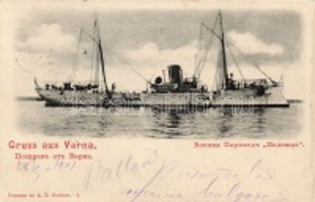 |
»The S.S. 'Nadezhda' in Varna
-
this old PPC from a Bulgarian
(?) online collectibles
catalog may not show the right boat
(May 18–23) On Cunard liner S.S. 'Pannonia' from Piraeus to Marseilles and by train on to Paris.
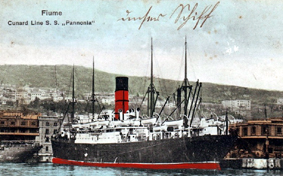 |
»The Cunard liner S.S. 'Pannonia'
Col. PPC, before WWI
(May 27) The whole family crosses from Le Havre to Southampton.
(From June) V. D. Nabokoff (Vladimir's father) rents an apartment at 55 Stanhope Gardens, South Kensington, London; later at 6 Elm Park Gardens, Chelsea, London.
(October 1) Nabokov enrolls at Trinity College, Cambridge University; two rooms assigned to him and fellow Russian expatriate Mikhail Kalashnikov in the south-western corner of Great Court (R6 = staircase R, set 6, 2nd floor).
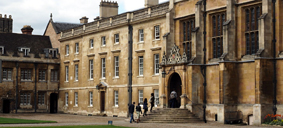 |
|
»Cambridge,
Trinity College, Great Court –
the SW corner Source: Trinity College Web information material |
1920
(January) Rents a room from Mrs. Alice Newman at 2 Trinity Lane, a crooked narrow street just south of the Great Court.
_MIN.jpg) |
| »Cambridge,
Trinity Lane Photo: Paul Glazzard 2006/ Wikimedia |
(From early
August 1920
to September 5, 1921) V. D. Nabokoff
and his family move from London to Berlin-Schmargendorf,
Egerstrasse 1. They
rent the large first-floor apartment from the widow of Rafael Loewenfeld,
the German translator of Tolstoi and Turgenev.
V.D. Nabokoff's mother Baroness Maria Korff who has escaped from the
Russian turmoils in a freight car comes to lodge with the family
in London and Berlin but
after V.D. Nabokoff's death moves to
Dresden, from Dresden to Romania
and dies 1925 in Bucharest.
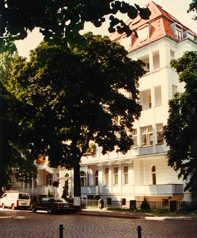
»Egerstrasse 1 (building
modernized)
Photo: ©DEZ 1996
(November 27) For the
first time the newly founded Russian émigré newspaper Rul (The
Rudder) publishes a poem (The Forest) by Nabokov, signed Cantab. In
the following years Rul was to publish one poem and one story after the
other. Editor-in-chief was Nabokov's unfailing sponsor Joseph Hessen, a
colleague and friend of his father.
Rul was supported by the editorial company Ullstein, and its editorial
offices were in Ullsteinhaus, Berlin-Kreuzberg, Kochstrasse 22
(since 2008 Rudi-Dutschke-Strasse), from 1924
on
Zimmerstrasse 7-8. That's where Nabokov went regularly to hand over
his manuscripts to Hessen in person.
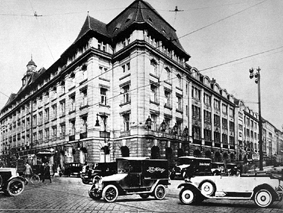 |
|
»The Ullsteinhaus
on Koch- and Friedrichstrasse PPC, c.1927 |
1921
(June 13) From Cambridge to Berlin, to join his parents at Egerstrasse 1, Berlin-Schmargendorf.
(Mid-June) Through his Cambridge roommate Mikhail Kalashnikov Vladimir meets Mikhail's cousin Svetlana Romanovna Siewert (1905-2000) in Berlin-Lichterfelde, Ringstrasse 77.
(September 5) V.D. Nabokoff and his family move to a less expensive apartment at Sächsische Strasse 67, Berlin-Wilmersdorf.
(October 7) Back to Cambridge, 2 Trinity Lane.
(December 8) With his Cambridge friend Bobby De Calry (Count Robert Louis Magawly-Cerati) to Switzerland (Champéry and St. Moritz) for an ice-skating and skiing holiday; return trip to Berlin via Lausanne where both of them go to see Cécile Miauton, Nabokov's former governess ("Mademoiselle").
1922
(January 17) Back to Cambridge for the Lent term.
(March 18) Back to Berlin for the Easter vacation.
(March 28) Assassination of Vladimir Dmitrievich Nabokoff by two Russian monarchists (Peter Shabelsky-Bork and Sergey Taboritsky) in the Berlin Philharmonie, Bernburger Strasse 22/23, during a meeting of the exiled Constitutional Democratic Party. The actual target was the party's founder, Pavel Milyukov, who got away unhurt. V.D. Nabokoff had attempted to protect him.
(March 30) Memorial service at the church of the Russian Embassy, Unter den Linden.
(March 31) Memorial service at the chapel of the Russian Cemetery in Berlin-Tegel.
_MIN.jpg) |
»V.D. Nabokoff's grave in the Russian cemetery of Berlin-Tegel, Nabokov's mother standing at its head, summer 1922 Source: Dmitri Nabokov |
(April 20) Nabokov returns to Trinity College to finish his university studies.
(June 21) After final examinations (second-class honours, roughly equivalent to a bachelor's degree), VN returns from Cambridge to join his widowed mother still living with her three younger children (Olga, Kirill and Elena) at Sächsische Strasse 67, Berlin-Wilmersdorf.
(July)
Nabokov proposes to Svetlana Siewert, then seventeen, in the Berlin
aquarium; she accepts but her father insists
that he better first earn a living.
(Late July) Travels with Svetlana Siewert's mother Klavdia and her family to Bad Rotherfelde, a summer resort in the Teutoburger Wald.
1923
(January 9) Urged by her father, mining engineer Roman Siewert, Nabokov's fiancée Svetlana Siewert breaks off her engagement to him; thus his visits to the Siewert family at Ringstrasse 77 come to an abrupt end. Nabokov is open for a new love.
(April 4) Reading his poetical works at Schubertsaal, Bülowstrasse 104, Berlin-Schöneberg (in the Deutsches Zahnärztehaus).
(May 9, Wednesday) Meets Vera Evseevna Slonim at an emigré charity ball at Tanzpalast "Fiametta" in Berlin-Halensee, Kurfürstendamm 119/120, from 9 p.m. till morning. It was a masked ball; she wore a black mask with a wolf's profile which she never lowered that evening. They walk homewards together to Berlin-Wilmersdorf as far as Hohenzollernplatz, he going on to his mother's flat on Sächsische Strasse 67, she to her family's flat on Landhausstrasse 41, Berlin-Wilmersdorf. (The Nabokovs later insisted the ball was on May 8.)
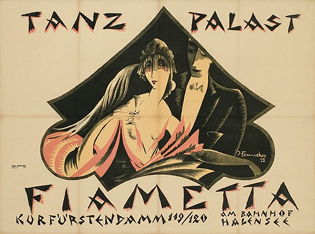 |
(End of May to
end of July)
Works as a farm hand at the Domaine de Beaulieu (vinyards and
orchards belonging to Bespalov and managed by
agronomist and Crimean Constitutional Democrat
Solomon Samoylovich Krym,
a friend and colleague of V.D. Nabokoff).
The Domaine de Beaulieu is about 4 km SE of the fruit-market town of
Solliès-Pont (Var),
France, c. 15 km NE of Toulon,
nowadays producing mainly
figs.
The closest localities are Les Maures and La Jonquière (today part of
Solliès-Ville). On the east of the Domaine's orchards is a streamlet, Petit
Réal. Solliès-Pont appears as 'Molignac' in Nabokov's 1932 novel Glory where
he describes his work on the fruit plantation: cherry, apricot and peach picking and tending
the irrigation of the nurseries, mostly along with Italian farmhands. Here
are directions for anyone wanting to drive there: From the train station of
Solliès-Pont take Route D58 (Chemin de Sauvebonne) to the junction with
new Route 258 Annexe, turn left in easterly direction until you hit the corner
of a narrow road called Le Grand Beaulieu. The buildings on the left are
those of the former Domaine. (Thanks for useful hints to Dutch Nabokovian Gerard de
Vries who wrote a hilarious article about a 1992 visit to Beaulieu on Zembla.)
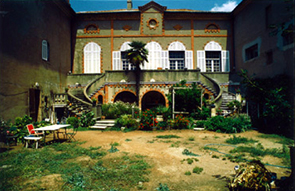 |
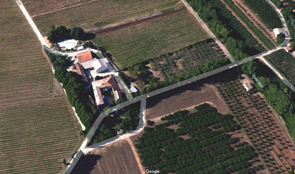 |
| »Former Domaine de Beaulieu,
court yard and main building Photo: ©Gennady Barabtarlo, 1992 (with permission) |
»Satellite
view of the Domaine de Beaulieu, today, with a new road
in front and several new buildings in back Source: Google Maps, 2018 |
(Late July, early August) In Marseille. Nabokov is offered a job as a stoker on a boat to Indochina. Writes to Véra in Berlin.
(August 19) Back in Berlin with his parents, Sächsische Strasse 67.
(October) Without any means to continue her life in Berlin, Nabokov's mother, Elena Nabokoff, relocates with her youngest daughter (Elena) to Prague where she and other prominent Russian refugees were offered a modest government pension; her other daughter (Olga) follows; Sergey is still in England. First they live in the villa of Czech statesman Karel Kramař, then in a small and bare apartment at Třida Svornosti 37, Smíchov district, on the west bank of the Vltava river.
(December 29) Nabokov escorts his youngest brother Kirill and the girls' governess Evgenia Konstantinovna Hofeld (1884-1957) on their move to Prague. There he writes much of The Tragedy of Mr. Morn. His return to Berlin is delayed mainly because he lacks the money for the return trip and because without sufficient funds he would not be able to rent a room for himself, the hyperinflation being over.
1924
(January 27) Nabokov finally returns by train from Prague to Berlin, Anhalter Bahnhof.
(From January 31) Pension Helene Andersen, Lutherstrasse 21, third floor, Berlin-Schöneberg. The Lutherstrasse does not exist any more, nor are there any pictures of it. It was in the continuation of today's Martin-Luther-Strasse, in part corresponding to today's Keithstrasse.
(August 17 to 28) Visiting with his mother in Prague who temporarily has relocated the family to a single room in a relatively expensive hotel in the vicinity, at Dobřichovice.
(From late August) Pension Elisabeth Schmidt, Trautenaustrasse 9, Berlin-Wilmersdorf.
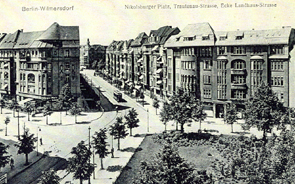 |
| »Trautenaustrasse,
Berlin-Wilmersdorf PPC, c.1925 |
1925
From April to late July) Luitpoldstrasse 13, Berlin-Schöneberg, 2 rooms, c/o canned goods merchant Erich Rölke.
(April 15) Married to Véra Slonim, at the townhall of Berlin-Wilmersdorf, Brandenburgische Strasse 2.
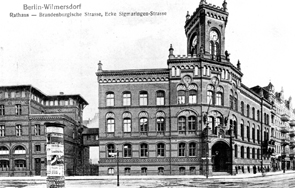 |
| »The Wilmersdorf town-hall PPC, c.1900 |
(August 1 to c. August 15) With Véra to meet his family at Villa Kaura 60, Radošovica near Prague.
(August) Escorts his pupil Alexander ("Shura") Sack to the beach resort of Zoppot (now Sopot) near Gdansk.
(August 27 to c. September 4) Hiking tour with his pupil Alexander ("Shura") Sack across the Schwarzwald: Freiburg (Hotel Römischer Kaiser, Kaiserstraße 120), Döggingen, Boll, Reiselfingen, Titisee, Feldberg, St. Blasien, Wehr, Todtmoos (Gasthaus zum Adler), Säckingen, Waldshut, Konstanz.
(September 4 to September 12) Constance, Pension Zeiss, Neuhauser Strasse 14.
_PPC1907_MIN.jpg) |
|
»The
spa of Boll, Black Forest Source: Wikipedia |
(Mid-September) Temporarily lives in Véra' apartment, Luitpoldstrasse 13, Berlin-Schöneberg. Here he starts to write his first novel, Mashenka (in English Mary).
From September 30) Motzstrasse 31, Berlin-Schöneberg: 2 rooms, c/o Frau M. v. Lepel (a major's widow).
 |
| »Motzstrasse,
Berlin-Schöneberg PPC, c.1910 |
(From c. December 25 to January 3, 1926) Skiing with Véra and Sergey Kaplan in Krummhübel (Silesia), today Karpacz (Poland).
1926
(March 21) Publication of Nabokov's first novel Mashenka by the émigré publishing house Slovo, associated with Rul and Ullstein.
(June 2 to c. July 20) Véra is away in several sanatoria in the Black Forest, mostly in St. Blasien and Todtmoos, while VN stays in a Russian pension on Nürnberger Strasse, Berlin-Schöneberg.
(June) Preparing an article on Soviet fiction, VN takes out a kind of subscription at a Russian bookstore and lending library, "Ladyzhnikov", Rankestrasse 33, Berlin-Charlottenburg, that allows him to borrow as many recent Russian books as he wishes.
(July 13) Participating as defendant in a mock trial, staged by the Union of Russian Journalists and Writers, of Pozdnyshev, the hero Tolstoi's Kreutzer Sonata, in the Schubert-Saal, Bülowstrasse 104, of the Deutsches Zahnärztehaus, the same address as the other favorite lecture hall of Russian Berlin, the Guttmann-Saal which was dedicated mainly to Jewish events.
(Summer) Chaperoning two boys, Abraham/"Rama" (13) and Joseph/"Ossia" (11) Bromberg, in the Baltic sea resort of Binz, on Rügen island. Nabokov had given the boys tennis lessons in Berlin. Their parents were cousins of Véra's family, the Feigins. The father Herman Bromberg was a well-to-do businessman in the fur trade who with his wife Elena Lvovna eventually moved from Berlin to Leipzig, Ehrensteinstrasse 34-I. After the boys left, the Nabokovs for a short while moved on to the nearby Pomeranian resort of Misdroy (today Międzyzdroje, Poland).
(From autumn) Passauer Strasse 12, Berlin-Schöneberg: 2 rooms, c/o merchant Horst von Dallwitz.
1927
(Summer) Again chaperoning the two Bromberg boys in the Baltic seaside resort of Binz on Rügen Island, living
in a fisherman's house, collecting butterflies in the Granitz, a beech tree forest on a hill with a cliff coast SE of
Binz, and conceiving his second Russian novel, King, Queen, Knave.
_MIN.jpg) |
|
»Binz on Rügen Island,
beach and casino Col. PPC, c.1925 |
1928
(June) Finishes King, Queen, Knave.
(Several weeks in July) At the Baltic seaside resort of Misdroy (today Międzyzdroje, Poland), together with Mikhail and Elizaveta Kaminka.
(September/October) Publication of King, Queen, Knave.
1929
(February 8 to June 24) With the money earned from the German translation of King, Queen, Knave, Nabokov treats himself to a butterfly trip to the Pyrenees, first to Le Boulou (Pyrénées-Orientales), Hôtel Établissement Thermal, where it turns out too windy, then (from April 24) at Saurat (Ariège). In Le Boulou he begins writing Zaschita Luzhina (Luzhin's Defense), later English title The Defense. The Russian title is mostly understood as "the chessplayer Luzhin's defense" (against his opponent or against insanity) but should perhaps be understood as "the Luzhin Defense".
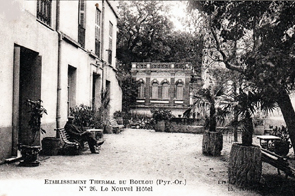 |
|
ȃtablissement Thermal, Le
Boulou (P.-O.) PPC, 1920s |
(July) Nabokov and his wife live for the remainder of the summer (he working on The Defense) in a backyard shack of the local innkeeper and sub-postmaster in the village of Colberg (today Heidesee-Kolberg), about 35 miles SE of Berlin, after they had acquired a small lot of land on nearby Lake Ziest where they hoped to build a sort of dacha within two years. However, next year they let the land revert to the seller for lack of payment. This was the only time in the sixty years of his exile that he attempted to buy some real estate and settle there. The only local inn ("Alter Dorfkrug") had a few regular guest rooms but they were booked out in the summer of 1929 when the Nabokovs arrived, so the innkeeper could only offer them a makeshift shack in his backyard.
_MIN.jpg) |
_MIN.jpg) |
|
»The
"postman's shack" at Kolberg Photo: ©DEZ 2014 |
»Lake Ziest near
Kolberg Photo: ©DEZ 2014 |
There has been some controversy about the exact location of Lake Ziest as there are two forest lakes by this name in the region. There even is a German novel on somebody's unsuccessful search for Nabokov's lake (Jens Sparschuh, Ende der Sommerzeit). One of the two lakes is the smaller Ziestsee south of Kolberg. This is where the Nabokovs lodged that summer and where they had made a down payment for their lakeshore plot. The other is the larger Ziestsee near the village of Bindow, about seven linear kilometers to the northwest. This is where Nabokov staged the killing scene in his 1932 novel Despair; proof is a map VN drew in America for the novel. (Details in »Nabokov zwischen den Ziestseen.) There are no direct roads through the dense forest between the two lakes. So it remains a mystery how he acquainted himself with the topographic details of the larger Ziestsee which he used in his novel. (In VNRY p.290, Brian Boyd added to the confusion by writing that VN's lake-side plot was "on the Wolziger See" and not on "Ziestsee" as Véra had told him in one of his interviews. This was because he had seen a picture postcard from Kolberg written by Véra at the time which showed "Colberg am Wolziger See"; and because he knew the Nabokovs lodged in Kolberg on Lake Wolzig, he supposed Véra had misremembered the lake and that their land actually was on Lake Wolzig too.)
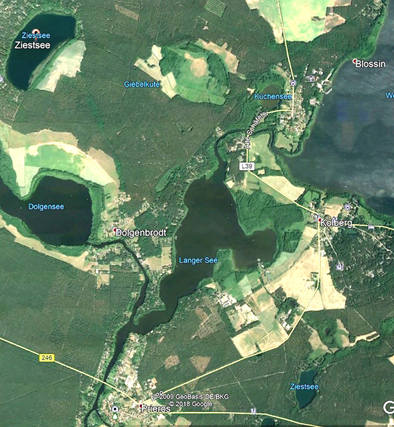 |
| The
Ziestsee of Despair
in the NW corner, Nabokov's Ziestsee in the SE
corner; north of it the village of Kolberg on big and shallow Lake Wolzig. Source: Google Satellite 2018 |
(August) Finishes [Luzhin's] Defense.
(From late August to January 1932) Luitpoldstrasse 27, Berlin-Schöneberg, 2 rooms (parlor and bedroom) in the "vast and gloomy" apartment of Oberstleutnant a.D. Albrecht v. Bardeleben.
(December 15) Publication of Vozvrashchenie Chorba.
 |
|
»Luitpoldstrasse,
Berlin-Schöneberg PPC, early 1900s |
1930
(May) Begins his fifth Russian novel, Glory.
(Around May 10 to May 25) Visiting his mother in Prague, 64-I Palackeho Třida, Karlin.
(From summer) On the basis of five hours a day, Véra finds a job as foreign language secretary (German, French, English) at the law firm Weil, Gans & Dieckmann, Landgrafenstraße 1, Berlin-Tiergarten, which is acting as counselor for the French embassy. It has to close in 1933. In his novel The Gift, Nabokov portrays it as the gogolesque office of "Traum, Baum und Käsebier".
(September) Publication of [Luzhin's] Defense which establishes Nabokov's literary fame in the Russian community of Western Europe.
(November) Finishes his novel Glory.
1931
(Winter) Begins writing his sixth Russian novel, Kamera obskura, later English title Laughter in the Dark, a novel VN
was never quite content with, despite several metamorphoses. It was aimed at being made into a film.
(May) Finishes Kamera obskura.
1932
(From January) Westfälische Strasse 29, Berlin-Wilmersdorf, 1 room, c/o Cohn family, opposite of his next, more durable address.
(April 3 to April 20) Visiting his mother in Prague, 64-I Palackeho Třida, Karlin.
(April 22) Reading scenes from Faust during a Goethe memorial evening in the Guttmann-Saal, Bülowstrasse 104, in the Deutsches Zahnärztehaus (the same address as the Schubert-Saal, the other favorite lecture hall of Russian émigré writers in Berlin).
(May 7) Traveling to Dresden for a reading in the basement of a Russian church.
(June) Begins writing his seventh Russian novel, Despair.
(From July 31 to January 18, 1937) Nestorstrasse 22, 3rd floor, left, Berlin-Wilmersdorf, 2 rooms, c/o Véra Nabokov's (Slonim's) cousin and friend Anna ("Anyuta") Feigin. This was the Nabokovs' last and most long-lasting address during their fifteen years in Berlin.
_MIN.jpg) |
| »Nestorstrasse 22, Berlin-Halensee PPC, c.1932 |
(September) Finishes his novel Despair.
(Early October to October 21) Vacationing with Véra at Villa Oda in Kolbsheim, Alsace, 8 miles W of Strasbourg, in a cottage where between 1928 and 1933 his cousin Nicolas ("Nika") Nabokov and his wife Nathalie ("Natasha") spent much of their summer holidays. Villa Oda at the end of the village had been given to him by Alexander Grunelius (a wealthy French-German businessman) and his wife Antoinette Grunelius née Schlumberger, owners of early 18th century Schloss Kolbsheim, rebuilt and redecorated, with its renowned landscaped gardens, with whom "Nika" had been friends since 1923. Grunelius also entertained other composers and writers like Milhaud, Prokoviev, Hindemith, Désormière and Cocteau.
(October 21 to November 13) On a reading and networking tour to Paris and Belgium, lodging with his cousin Nicolas Nabokov, 9 rue Jacques-Mawas, Paris 15e.
(November 2) The first of VN's occasional visits to his aunt Nina Dmitrievna Kolomeitsev née Nabokov, ex Rausch von Traubenberg, at her apartment on 16, avenue de la Grande Armée, Paris.
(November 4 to 26) Uncomfortably lodging in the crammed apartment of Nikolay Nikolaevich ("Koka") Rausch von Traubenberg (1880-1943) and his family, 122 Boulevard Murat, Paris 16e. The family consisted of "Koka" himself, his wife Maria née Menzelintsev (1884-1970) and the children Alexander Nikolaevich (1909-1965) from Koka's first marriage to Olga Ebeling and of Maria Obolensky (1914-1946) whom his second wife had brought into the marriage. "Koka" was the brother-in-law of VN's paternal aunt Nina Dmitrievna Nabokov, married first to Evgenii Alexander Rausch von Traubenberg ("uncle Zhenya") and then to ex-admiral Nikolai Nikolaevich Kolomeitsev.
(November 6) Publication of Glory.
(November 13–26) Still in Paris, as a houseguest of Ilya Fondaminsky, 1 rue Chernoviz, Passy.
(November 26–29) Readings in Antwerp and Brussels, Belgium.
(November 30) Back in Berlin.
1933
Soon after finishing his novel Despair, Nabokov begins making plans for his longest (and last) Russian novel,
The Gift, that is going to take him five years, starting with research for The Life of Chernyshevski (Chapter 4).
(December) Publication of Kamera obskura.
1934
(May 10) Véra's and Vladimir's son Dmitri Nabokov is born in the private
clinic of Dr. Friedrich Grambow,
Berchtesgadener Strasse 25,
Berlin-Schöneberg.
 |
|
»Berchtesgadener Strasse
25, Berlin-Schöneberg PPC, c.1925 |
(June 24) In the middle of writing his most extensive Russian novel The Gift (Chapter 4, Life of Chernyshevsky), Nabokov suddenly sets all other work aside and within a fortnight composes his novel Invitation to a Beheading.
1936
(January 21) Leaves for a lecture tour to Belgium and France. In Brussels he stays with Zinaida Shakhovskoy, the sister of Nicolas Nabokov's first wife Nathalie, and her husband, at 4, rue Washington. In Antwerp he gives a reading on January 27, not staying overnight.
(January 29) From Brussels by train to Paris where he stays with Ilya Fondaminsky, 130 Avenue de Versailles, Paris 16e. During his networking tours to Paris, Nabokov mostly was the house-guest of his kind and very helpful patron Ilya Fondaminsky and his wife Amalia, in 1932 at their apartment on 1 rue Chernoviz, Paris 16e, in 1936 and 1937 on Avenue de Versailles. Fondaminsky refused to leave Paris when the German occupation was imminent, was arrested in 1941 and murdered in Auschwitz in 1942.
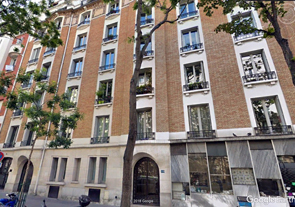
|
|
»130 avenue de
Versailles, Paris 16e Source: Google Street View 2018 |
(February 16-18) To Brussels once more, for another reading, then back to Paris.
(February 20) Publication of Otchaianie.
(February 28, Friday) Leaving Paris by train at 22:45, arriving in Berlin-Charlottenburg on Saturday, February 29, at 17:19. Back to wife and son in Berlin, Nestorstrasse 22, after 39 days of lecturing and networking abroad.
(May 27) The Russische Vertrauensstelle or "Russian Trust Agency"
(first In den Zelten 16, later
Bleibtreustrasse 27, Berlin-Charlottenburg) which since 1920 had
been quietly serving as a kind of unofficial substitute consulate
to help Russian émigrés in Germany in need of personal documents etc.
from Soviet
Russia is suddenly taken over by the Nazi government and
clandestinely run by the Gestapo. They want to
take full control of
the remains of the Russian community which has been shrinking since
the end of the
hyperinflation in 1923 but is still considerable, and
they are to prepare a list of the Jewish people among
them. The former
director, ex-diplomat
of Imperial Russia Sergey Botkin, did not get along with the Nazis and had left for Paris the year
before. This was all the more
aggravating for Nabokov as his father's assassin, Sergey Taboritzky,
pardoned after five years in prison and now a stout Nazi and from
1940 a member of the Nazi party NSDAP, was appointed deputy
director of the nazified Vertrauensstelle. Because for his various
travels to Prague, Paris, Brussels and London VN needed all kinds of
visas and permits, so he was rightly concerned he might have to face Taboritzky for the necessary affidavits.
(Details on Taboritzky and the Vertrauensstelle in
»What Happened to Sergey Nabokov?)
(Spring) Véra who is proudly Jewish once more
does find a
job as foreign secretary in a Berlin engineering
firm: Ruths
Speicher GmbH Wärmetechnik (thermal energy storage), Joachimthaler
Strasse 43, Berlin-
Wilmersdorf. After three months she and all other Jews are
forced out.
(June) Véra
visits with Anna Feigin's cousins, Herman Bromberg and his wife Elena Lvovna,
in Leipzig,
Ehrensteinstrasse 34-I.
1937
(January 18)
Leaves for another lecture and networking tour to Brussels, Paris, London
and again Paris, with
the intent never to return to Germany.
Véra and Dmitri are to follow when everything is smoothed out
for
them.
(February 20
to March 1)
Continuing his
networking trip to London, staying at the apartment of
Maria Zetlin,
Notting Hill, 15 Princes House, 52 Kensington Park Road.
(Around February 25) One day visit to Cambridge and Trinity College.
(March 2 to
May 20) Paris, c/o Ilya Fondaminsky, 130 avenue de Versailles,
Paris 16e. Making plans to meet
Véra and Dmitri
in Southern France or in Prague, discussing them in almost daily letters with Véra who
appears
unsure what action to take, waiting for papers and permits for the coming
family travels.
(April 1)
Véra,
Dmitri
and Anna Feigin give up their apartment
in Nestorstrasse and temporarily move to
Osnabrücker Strasse 21, Berlin-Charlottenburg, c/o Geballe.
Professor Cäsar Geballe and his wife were
Jewish and had only recently been
relocated to Osnabrücker Straße. In 1942 they were deported to
Theresienstadt and murdered in Auschwitz in 1944.
(May 6) Véra
and Dmitri leave Berlin for Prague. Nabokov is still
in Paris,
waiting for the
necessary passports,
carte d'identité and permis de séjour to
travel from Paris to Prague,
there to meet with his family
and
and to
take
them back
to Southern
France.
He wants to avoid going by way of Berlin, which would make the fare
less
expensive but where he might be obliged to see Sergey Taboritzky, his
father's assassin, who is now
deputy director of the Gestapo run
"Russische Vertrauensstelle" (Russian Trust Agency) for his travel papers.
It may be that Véra first went to Franzensbad
(today Františkovy Lázně) for some mudbaths to recover from
the
strain of the last months (an idea he disliked), possibly to a hotel named
Egerländer or Egerländer Hof.
(May 20,
Thursday, 10 p.m.)
At last the French authorities issue Nabokov a new Nansen
passport (the old
one had expired and should have been renewed in Berlin),
so finally he has the papers to leave Paris by train
for Chekhoslovakia via Switzerland and Austria, arriving in Prague on Saturday, May 22, 6:20 a.m.
where he
meets Véra, Dmitri, his mother and her companion Evgenia
Konstantinova Hofeld and his sister Olga. All of
them stay at his mother's two-room flat
on
Koulova 8, Dejvice-Praha.
(End of May
to June 18)
From his correspondence (Letters to Véra) it is not quite clear
whether they go to
Franzensbad or to Marienbad together.
(June 18 to
June 23) Nabokov returns
by himself
to Prague where he sees his mother for the last time,
Koulova 8,
Dejvice-Praha.
(June 23 to
June 29)
He returns from Prague to stay with Véra and Dmitri at Villa Busch, Marienbad
(today
Mariánské Lázně).
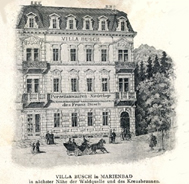 |
|
»Villa Busch
Part of PPC, early 1900s |
(June 30 to July 7) From Marienbad all three of them take the train to Paris where for a few days they stay with his steady patron Ilya Fondaminsky, 130 avenue de Versailles. Though Nabokov had planned to avoid Germany and go via Austria, Switzerland and Italy straight to Nice, they travel through Germany via Strasbourg to Paris because the fare is cheaper.
(July 8 to end of July) On to Cannes at the Côte d'Azur, Hôtel des Alpes, rue Saint-Dizier and rue Georges Clemenceau.
(c. July 14) Nabokov confesses to Véra his affair with Irina Guadanini-Kokoshkin that had been going on since January and about which she already had received a four-page anonymous letter, possibly by Irina's mother. After a stormy scene, he decides to stay with his family. "The worst evening of his entire life" (Brian Boyd, VNRY, p.440). Still he continues to write to Irina.
(End of July) Vladimir, Véra and Dmitri move to a two room apartment at 81 rue Georges Clemenceau, Cannes, opposite the Hôtel des Alpes.
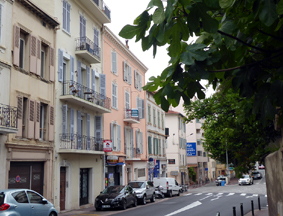 |
|
»81, rue Georges Clemenceau,
Cannes (second building left) Photo ©DEZ 2019 |
(Around September 2) Urged by her mother, Vera Kokoshkin, Irina travels to Cannes in the hope of prying Nabokov loose. She meets him on his way from his apartment to the beach for a morning swim with Dmitri, but he tells her to go. She does not but remains sitting on the beach a few steps from the Nabokovs. They ignore her and a few hours later leave for lunch.
(Mid-October) On to Menton (Alpes-Maritimes), Pension Les Hespérides, Place Saint-Roch, center of the town. The pension has been demolished, the buildings around the square have been reconstructed.
_MIN.jpg) |
|
»Pension Les Hespérides,
Menton PPC, 1920s |
1938
(January) Finishes The Gift in Menton. Its five chapters were written in the order 4 - 2 - 1 - 3 - 5.
A museum in Menton inspires VN's story The Visit to the Museum: "It has everything from paintings by Ferdinand Back to a ramshackle collection of faded butterflies. And do you know which statues stand at the entrance? Pushkin and Peter the Great..." (unpublished letter to Mark Aldanov). VN surely didn't have today's Fine Arts Museum in the Palais Carnolès in mind but Menton's oldest municipal museum, the Musée de Préhistoire Régionale (Rue Lorédan Larchey), opened in 1909 mainly to house the natural history cabinet of a local collector, Stanislas Bonfils. His diversified collection is gone, except for the exhibits that fitted into today's museum of regional prehistory.
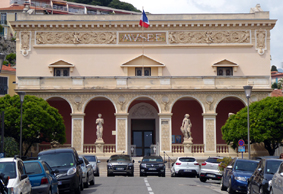 |
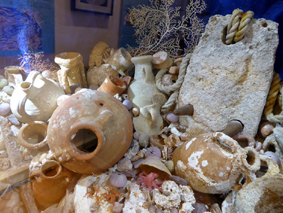 |
»Musée de Préhistoire Régionale, Menton Photo ©DEZ 2019 |
»An exhibit
at the Musée: submerged pottery Photo ©DEZ 201 |
(Second week of July)
By bus to Hôtel de
la Poste,
Moulinet, Alpes-Maritimes,
where he hopes to hunt butterflies and actually
catches one he has reason to believe is a new species, the Blue Lysandra
cormion (it was not but decades later was proven to be a natural hybrid).
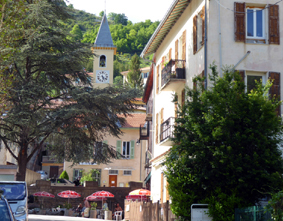 |
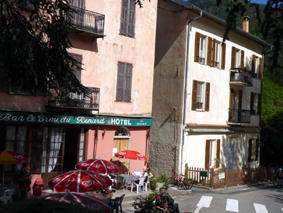 |
|
»Moulinet,
former Hôtel de la Poste, foreground right |
»Moulinet,
former Hôtel de Paris and former Hôtel de la Poste (right) Photos ©DEZ 2019 |
(Late August) As the restaurant kitchen in the Hôtel de la Poste where they had taken lodgings turned out to be too unsanitary and the kitchen of the "first place in town," the adjacent Hôtel de Paris likewise, the Nabokovs escaped from Moulinet and moved on to Villa Les Cyprès, 18 chemin de l'Ermitage, Cap d'Antibes.
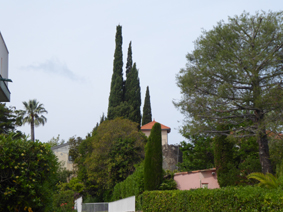 |
|
»Cap
d'Antibes: the grounds of Villa Les Cyprès, seen from the back side Photo ©DEZ 2019 |
Writes the Russian play Izobretenie Val'sa (The Waltz Invention) in September, to be produced by the Russian theater in Paris in 1939, WWII throttling these plans. (The play is not about waltzing; the protagonist's name is Val's.)
(October 2) Publication of Sogliadatai (The Eye)
(Mid-October) From Cap d'Antibes to the farmhouse of Mikhail and Elizaveta Kaminka at L'Honor-de-Cos (Tarn-et-Garonne) near Montauban.
(Late October) To a one-room apartment in Paris 16e, 8 rue de Saigon, his second-to-last abode in Paris.
(November 17) Publication of Proglashenie na kazn' (Invitation to a Beheading)
 |
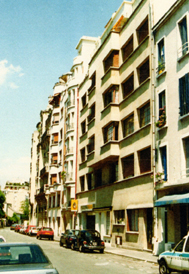 |
|
| »8
rue de Saigon, Paris 16e Photo: ©DEZ 1996 |
»59
rue de Boileau, Paris 16e Photo: ©DEZ 1996 |
(December) Begins writing his first English novel, The Real Life of Sebastian Knight. Because of the crowded conditions in the rue de Saigon flat, he writes in the bathroom, placing a suitcase over the bidet.
1939
(From mid-February) Hôtel Royal Versailles, 31 rue Le Marois, Paris 16e. In spite of its glorious name, Boyd says the Nabokovs found it "small and shabby". It has been defunct for decades.
(April 1 to last week) Nabokov travels to London, in search of employment, staying with Evgeny Sablins, 5 Brechin Place, Kensington, London SW 7, until April 16 and from April 17 with Michael and Maria Zetlin, 47 Grove End Gardens, London NW 8.
(From late April) At 59 rue Boileau, Paris 16e, a dingy and empty two room flat.
(May 2) Nabokov's mother Elena Ivanovna Nabokova, aged 62, dies in a Prague hospital from an abscess on the lung.
(May 31–June 14) In London again, in search of employment, staying with Vera Haskell, 22 Hornton Street, South Kensington.
(Between June 17 and 25 to September 2) With some money unexpectedly coming in from the sale of one of his stories (The Potato Elf?) to an American magazine (Esquire?), the Nabokovs could afford a summer vacation in the South, first going to the Pension Briandon in Seythenex (Haute-Savoie), near Albertville, and then to a Russian pension (Rodnoy) in Fréjus (Var), on the French Riviera, hunting butterflies and revising The Waltz Invention. They returned to their little Paris apartment the day before the outbreak of WWII on September 3.
(From September 2) Back in Paris, 59 rue Boileau. In June, 1940, a few weeks after his arrival in New York, Nabokov told a reporter (Nikolay All) from the Novoe Russkoe Slovo: "A few days ago I got a letter from friends in Paris. They write that the house where I had been living with my wife and son before we left had been hit by a bomb from a German plane and was completely destroyed."
(October and November) Writes his Russian novella The Enchanter, a predecessor of Lolita, and then forgets about it. It is going to be published posthumously only in 1986.
1940
(May 19) The Nabokovs embark on the CGT (Compagnie Générale Transatlantique) liner S.S. 'Champlain' from St. Nazaire to New York. (Because of the ongoing submarine war, she sailed from St. Nazaire and not as usual from Le Havre.) Four weeks later, on June 14, German troops will occupy Paris. On her way back to France, probably to La Rochelle, on June 17, the 'Champlain' struck a German air-laid mine off La Pallice near the Île de Ré and heeled over on her side. A few days later, she was finished off by a German torpedo. Parts of the wreck remained visible above water and were scrapped only in 1967.
_MIN.jpg) |
| »S.S. 'Champlain' |
(May 26) The 'Champlain' anchors off Quarantine (Ellis Island) in New York Harbor.
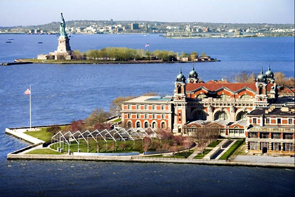 |
|
»Ellis
Island Source: www.jeparsauxusa/ |
(May 27) Arrival in New York City. Subsequently the Nabokovs are for a few days house-guests of Nathalie Nabokoff née Princess Nathalie Shakhovskaya, former wife of cousin Nikolas Nabokov, 32 East 61st Street.
(From June 10) The Nabokovs move to a cheap summer sublet c/o Mr. and Mrs. Lehovich, 1326 Madison Avenue.
(From July 15) They move on to the country home of a helpful ex-Russian sponsor, Harvard professor Mikhail Karpovich and his wife Tatiana near West Wardsboro, Vermont.
(Mid-September) On their return from Vermont to New York City, they rent two rooms on 35 West 87th Street, New York, "a dreadful little flat" (Véra).
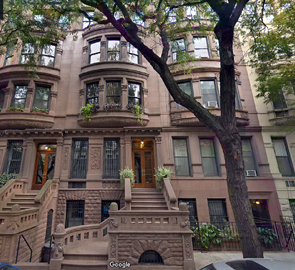 |
|
»35
West 87th Street, New York, modernized c.2015 Source: Google Street View 2018 |
1941
(Early February) Nabokov's first college lecture at Well's College, Aurora, New York, where his cousin Nicolas Nabokov had been teaching music for several years.
(March 15) Invited to Wellesley College for a two weeks' round of talks on Russian literature, staying on the campus (Claflin Hall).
(March 30) Side trip to Ridgefield, Connecticut, lecturing, then back to New York City.
(May 26) Begin of first trip to the West, by car, make Pontiac (dubbed Pon'ka, pony), owned and driven by a helpful New York Russian pupil and acquaintance, Dorothy Leuthold. First day from New York City to Gettysburg, Pennsylvania, Motor Court Lee-Mead.
(May 27) To Luray, Virginia, Parkhurst Inn & Cottages.
(May 28) To Bristol, Virginia, General Shelby Hotel.
(May 29) To the Smokie Mountains and Belva, Tennessee, Maple Shade Cottages.
(May 30) To Crossville, Tennessee, Cumberland Motor Court.
(May 31) To Jackson, Tennessee, George Anna Hotel.
(June 1) To Hot Springs, Arkansas, Wonderland Court, 2012 Central Avenue.
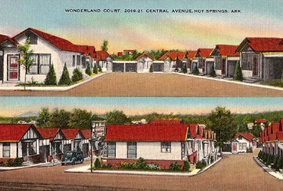 |
| Wonderland Court, Hot Springs AR PPC |
(June 2) To Dallas, Texas, Grande Tourist Lodge.
(June 3) To Lubbock, Texas, Motor Hotel.
(June 4) To Santa Fé, New Mexico, El Rey Court.
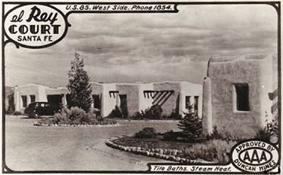 |
| El Rey Court, Santa Fe NM PPC |
(June 6) To Holbrook, Arizona, Forest Court.
(June 7) To the Grand Canyon, Arizona, South Rim, Bright Angel Lodge.
(June 9) To Las Vegas, Nevada.
(June 10) To San Bernardino, California.
(June 11) To Santa Monica, California (Mission Court?).
(June 13) To Fresno, California.
(June 14) Arrival in Palo Alto, California; stay at a rented home on 230 Sequoia Avenue, teaching two summer courses at Stanford University (on "Modern Russian Literature" and "The Art of Writing", with an emphasis on playwriting).
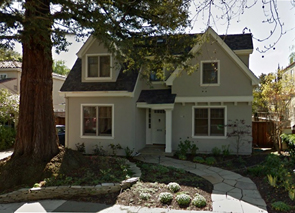 |
|
»230
Sequoia Avenue, Palo Alto, California Source: Google Street View 2011 |
(First week of September) Ten days driving around Yosemite National Park.
(September 11) By train back to Wellesley, Massachusetts, living on 19 Appleby Road.
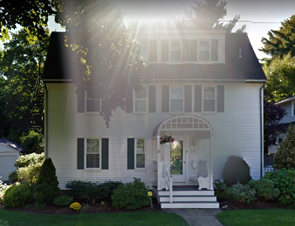 |
|
»19 Appleby Road,
Wellesley, Massachusetts Google Street View 2013 |
(December 6) Publication of The Real Life of Sebastian Knight.
1942
(Summer) At country home of Harvard professor Mikhail Karpovich and his wife Tatiana near West Wardsboro, Vermont.
(September 1) Moving into the apartment block 8 Craigie Circle, Apt. S 35, Cambridge, Massachusetts, where they are going to stay for several years. From here Nabokov goes to lecture in Wellesley and from 1942 to 1948, to do entomological work at the Harvard Museum of Comparative Zoology.
_MIN.jpg) |
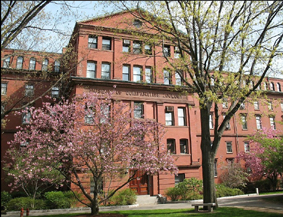 |
|
»8
Craigie Circle, Cambridge, MA Source: Web publicity of Cambridge realtors |
»Harvard's
Museum of Comparative Zoology (MCZ) Source: MCZ management, 2013 |
(September) Véra's cousin Anna ("Anyuta") Feigin who had moved from Berlin to Nice before the German invasion of France arrives in Baltimore from Lisbon.
(October 1) Start of a lecture tour to the southern states, beginning at Coker College, Hartsville, South Carolina (Salmon Hotel).
(0ctober 6) At Spelman College (a black women's school) in Atlanta, Georgia.
(October 14) At Georgia State Women's College, Valdosta, Georgia. Returning to Boston after another stopover for a lecture at the University of the South in Sewanee, Tennessee.
(November 5) On the "Dixie Flyer" from Boston to Chicago, Illinois ("a very beautiful railway station") and on to Springfield, Illinois.
(November 7) On the "Twin Cities Zephyr" from Chicago to St. Paul, Minnesota, where he stays at a "very fancy" hotel and lectures on the novel at Macalester College (he has forgotten to bring his manuscript and has to improvise the talk).
(November 11) Lecture at Knox College, Galesburg, Illinois, and then back home to Boston.
(December 7) From Boston via New York City to Honors College (part of State Teachers College) in Farmville, Virginia.
1943
(June 22) By train from Chicago to Salt Lake City, Utah, and from there c.30 miles SE to Little Cottonwood Canyon in the Wasatch Range, to stay at the Alta Lodge, today a posh ski-hotel with 57 rooms. It had just opened in 1940 with 12 rooms. Its founder and (co-)owner was publisher James Laughlin, a poet and the wealthy heir to a Pittsburgh steel company who in 1936 had founded New Directions publishing house. In 1943 Nabokov was writing his book on Nikolai Gogol for New Directions. As because of the war there were few paying guests for the lodge's twelve rooms (today there are 57), Laughlin let his author a room at an affordable price. Nabokov loved the butterfly hunting in the Wasatch Range, and one night at the picture window of his room caught a tiny geometrid moth that turned out to be "new" and was to become the only lepidopteron to bear his name as its species name, Eupithecia nabokovi (McDunnough, 1945), in short "Nabokov's Pug".
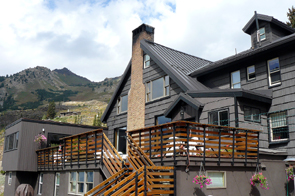 |
| »Alta Lodge, Little Cottonwood Canyon, Utah Photo: ©DEZ2007 |
(Early September) Back in Cambridge, 8 Craigie Circle, to teach an extracurricular Russian language course in Wellesley, to do entomological work at the Harvard Museum of Comparative Zoology (MCZ) and to write his first American novel, Bend Sinister.
1944
(Around June 5) Véra accompanies her son Dmitri to New York City where he undergoes an appendectomy. She stays at the flat of her cousin and friend Anna ("Anyuta") Feigin, 250 W 104th Street, app. 43.
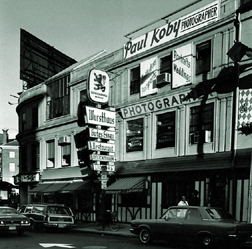 |
|
»The
'Wursthaus' on Harvard Square Source: Cambridge Historical Society |
(June 6, Tuesday) Food poisoning (haemorrhagic colitis) from eating Virginia Ham with spinach at the Wursthaus Restaurant at 4 Boylston Street (now John F. Kennedy Street) near Harvard Square (closed 1996). Is immediately taken by an ambulance to the Cambridge City Hospital and, still in a critical condition, with the help of a friend, Professor Karpovich's wife Tatyana, transferred to the Mount Auburn Hospital, 330 Mount Auburn Street, Cambridge, Massachusetts.
(June 9, Saturday) As soon as he has fairly recovered, he flees over the fire-escape into Mrs. Karpovich's car.
1945
(February 9-10) Lord Baltimore Hotel, Baltimore, Maryland, for a lecture at St. Timothy's College. Afterwards for a lecture at Smith College, Northampton, Massachusetts.
(From summer) Wellesley, Massachusetts, 9 Abbott Street.
(July 12) After passing their citizenship test, Nabokov and his wife become citizens of the United States.
1946
(Around June 20) By train and bus to New Hampshire where they spend the summer "on the shores of a dismal lake [Newfound Lake] at a horrible place called Don Jerry Lodge".
(Ffrom August 18) 6 Cross Street, Wellesley, Massachusetts.
1947
(June 12) Publication of Bend Sinister.
(Mid-June to September) By train from Wellesley, Massachusetts, to Estes Park, Colorado; staying at Columbine Lodge above Estes Park, collecting butterflies on the flanks of Longs Peak (e.g., Boloria freija), as described at the end of Chapter 6 of Speak, Memory.
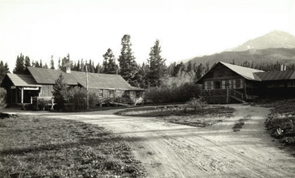 |
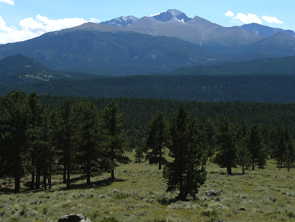 |
|
»Columbine
Lodge, Estes Park, Colorado |
»Longs Peak, Colorado, seen from near Estes Park Photo: ©DEZ 2007 |
1948
(From July 1) 927 East State Street, Ithaca, New York (home of Professor Batz Hansteen). This was the first of ten professorial homes in Ithaca the Nabokovs rented while their owners were on leave or on sabbatical for a year.
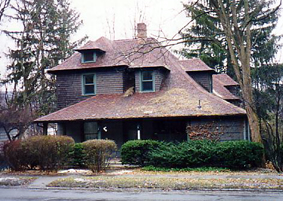 |
|
»927 East State Street Photo: ©Akiko Nakata 1997 |
(Sep 24) Nabokov's first Cornell lecture for his Russian Literature 151-52 course at room no. 248, Morrill Hall. Most of his forthcoming lectures would take place in the classrooms of Goldwin Smith Hall where he also was to have an office (room no. 278).
_MIN.jpg) |
|
»Goldwin Smith Hall, Cornell
University Photo: ©DEZ 1997 |
Buys a
second-hand beige 1940 Plymouth 4 door
Sedan.
The driver is
Véra
who has taken driving lessons.
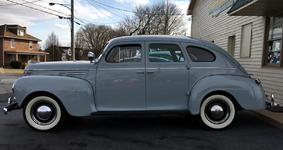 |
| 1940 Plymouth 4-door Sedan |
(From September 1) 802 East Seneca Street, Ithaca, New York (home rented from Mrs. Lotte Orndorff). According to Nabokov it was "a dismal grayish white frame house subjectively related to the more famous one at 342 Lawn Street, Ramsdale, New England" [where Lolita lives with her widowed mother] (Brian Boyd, VNAY, p.131).
_MIN.jpg) |
|
»802 East Seneca Street Photo: ©DEZ 1997 |
1949
(June 22 to July 16) First butterfly tour to the West with his own car (a second-hand black 1946 Oldsmobile, always driven by Véra), driving from Ithaca along a route below the Great Lakes and across Iowa and Nebraska (as Humbert and Lolita do on their second trip) and arriving on July 3 in Salt Lake City, Utah, where he attends a writers' conference, staying at Sorority House Alpha Delta Phi (July 16).
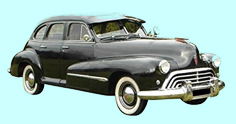 |
| 1946 Oldsmobile Source: Amazon |
Driving from Salt Lake City to Jackson Hole, Wyoming, staying at Battle Mountain Ranch in Hoback Canyon and at Teton Pass Ranch in Wilson, Wyoming.
(End of August) Driving back from the Grand Tetons to Ithaca, New York, via Minnesota, north of the Great Lakes and southern Ontario.
(September 4) Back in Ithaca.
1950
(June) Hotel The Vendome, Commonwealth Avenue and Dartmouth Street, Boston, Massachusetts. The Vendome was a Boston luxury hotel, opened in 1882, that in 1972 fell prey to "the worst firefighting disaster in Boston history".
(June 1) Boston dentist Dr. Favre ("a wonderful Swiss") extracts his last six teeth.
(June 2) On his way back from Boston to Ithaca, Nabokov stops at the Pine Bush Preserve on Old Karner Road eleven miles northwest of Albany, New York, where he expected the Blue Plebejus melissa samuelis to fly, and is fortunate to take a few specimens. He had described and named it from museum specimens in 1943, believing it was a subspecies of the Melissa Blue. Later the "Karner Blue" turned out to be a species in its own right (Plebejus samuelis, Nab. 1943), probably Nabokov's most important entomological discovery. In the following years he regularly revisited the Pine Bush Preserve on his trips between Ithaca and Cambridge to look after "his" butterfly.
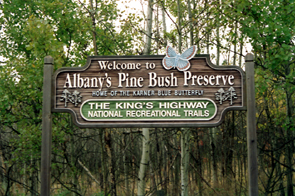 |
| »Home of the Karner Blue Photo: ©DEZ 1993 |
(June/July) Desperate that his workload would ever allow him to finish Lolita, he takes the manuscript to the garden incinerator at 802 East Seneca Street to burn it. His wife stops him.
1951
(February 14) Publication of Conclusive Evidence.
(From spring) 623 Highland Road, Ithaca, New York (home of Professor H.S. Sach). The house was in the locality Cayuga Heights, NW of the Cornell campus, favored by Cornell professors. For the next seven years, Nabokov was to successively rent at Cayuga Heights from professors on sabbatical..
_MIN.jpg) |
| »623 Highland Road Photo: ©DEZ 1997 |
(Late June)
Second trip in his 1946 Oldsmobile to the West.
After aborted attempts to rewrite his Russian
novella The Enchanter
in 1947, Nabokov now sets out in
earnest to compose
Lolita,
hunting butterflies in the morning, amassing notes and writing during the
rest of the day. For three years the novel will be his holiday work.
(June 30) Saint Francis, Kansas (on US 36).
(July 3 to 29) Telluride, Colorado (two nights at Skyline Ranch, then at Valley View Court).
(July 15) Hiking up Tomboy Road to Social Tunnel in search of the female of the Blue Plebejus ex Lycaeides idas sublivens, a subspecies he had recentliy been the first to describe on the strength of a male museum specimen only. (The "author" of a "new" butterfly has to deposit a male and a female to gain full recognition for it.) Telluride is at an elevation of 2,670 m; "Tomboy Road" leads up in easterly direction along the northern slopes of the Telluride Valley through "Social Tunnel" to the ghost town of Tomboy (3,506 m), a former gold and zinc mine, and on to Imogene Pass (3,997 m) in the San Juan Mountains. There are interpretations of Lolita claiming that the female Northern Blue VN was after at Telluride is a symbol of Lolita. VN hated this kind of symbolism. But Telluride does play a pivotal role in the novel. Though unnamed, it is where Humbert at the very end has his epiphany as he looks down from the equivalent of Tomboy Road to a flock of school children playing noisily and happily and realizes why Lolita could not be among them.
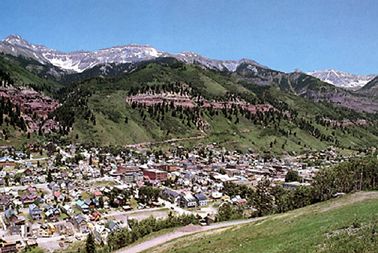 |
 Female of Plebejus idas sublivens (Nab., 1949), the "Northern Blue" |
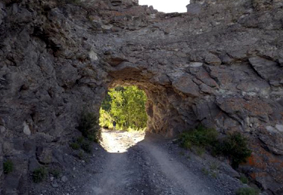 |
|
»Telluride,
Colorado – from
the hillside opposite the starting point of Tomboy Road, rising to the right (i.e. eastward) Photo: ©DEZ 1999 |
Source: W.H.Howe, The Butterflies of North America, 1975 |
»Tomboy
Road above Telluride passing Social Tunnel Source: F.P.Assa in Nabokov Online Journal, XII, 2018 |
(Early August) Driving from Telluride to Jenny Lake, Wyoming, and on to Duck Ranch N of West Yellowstone, Montana.
(Late August) Driving back to Ithaca.
1952
(From February 1 to June 20, as a visiting professor at Harvard) 9 Maynard Place (at the house of writer May Sarton), Cambridge, Massachusetts, and at the Hotel The Vendome, Boston, Massachusetts. Nabokov taught two Russian courses (one on Tyutchev, Nekrasov, Fet, Dostoyevsky, Tolstoy, Chekhov, Blok, Khodasevich, Mayakovsky, the other on Pushkin) and one on European novels (Cervantes, Dickens, Gogol, Flaubert, Tolstoy).
(April 26) First complete publication of Dar, in Russian.
(June 20) Departure for another trip to the West in his Oldsmobile, writing Lolita, the destination being the Continental Divide in Wyoming (for entomological reasons).
(End of June) Laramie, Wyoming, Lazy U Motel.
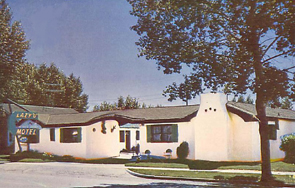 |
| »Lazy U Motel, Laramie, Wyoming PPC |
(July 4) Through Medicine Bow National Forest to Riverside, Wyoming, where too noisy celebrations are underway; soon leaving for Dubois, Wyoming, Rock Butte Court.
(Early August) Afton, Wyoming, Corral Log Cabins.
(September 1) Back in Ithaca. New address: 106 Hampton Road, Ithaca, New York (home of A.F. Wiegant).
1953
_MIN.jpg) |
|
29-35 Brewster Street, Cambridge, Massachusetts Source: Wikimedia Commons, Photo Daderot 2010 |
(From February 1) Two interim weeks at the "Robert Frost House", 29-35 Brewster Street, Cambridge, Massachusetts. A blue plaque on the left-hand corner states that poet Robert Frost (1874-1963) lived here during the last two decades of his life. At that time Frost was away in Florida. The house was cold, and according to Brian Boyd (VNAY, p.222) the Nabokovs felt made unwelcome by his study being locked. So until their departure West they rather moved to a hotel.
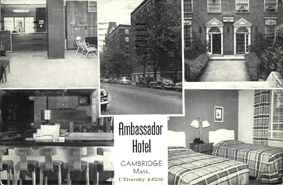 |
| Ambassador Hotel, Cambridge,
Massachusetts Source: PPC 1950s |
(Mid-February to April 7) Ambassador Hotel (now Coolidge Hall), 1737 Cambridge Street, Suite 617, Cambridge, Massachusetts.
(April 7) Departure for another trip west with their Oldsmobile, Véra driving, working on the final draft of Lolita.
Passing Birmingham, Alabama.
(End of April to early June) At a rented ranch in Portal, SE Arizona, hunting for butterflies in the Chiricahua Mountains (too windy), finishing Lolita, translating Conclusive Evidence into Russian.
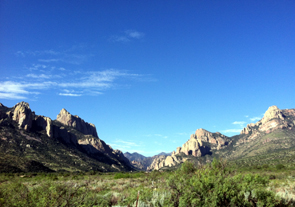 |
|
»Chiricahua Mountains near Portal, Arizona Source: Wikimedia Commons |
(Early June) On a account of Véra's dislike for rattlesnakes, they leave for Oregon.
(June or July) Begins writing his fourth English novel, Pnin, half a year before finishing Lolita.
(June, July and August) 163 Mead Street, Ashland, Oregon, in the home of Dr. Arthur Tailor.
(September 1) Leaving for Ithaca, New York, via Jenny Lake and the Tetons.
(December 6) Finishes the fair copy of Lolita.
1954
(From beginning of spring term) 101 Irving Place, Ithaca, New York (Cornell University faculty home).
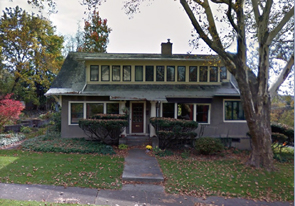 |
| »101 Irving Place Photo: ©DEZ 1997 |
(April 18) At the Eldridge Hotel, Lawrence, Kansas, to lecture at the University of Kansas.
(June 18) Leaving Boston for Cleveland, Ohio, and Taos, New Mexico, where they spend July and August at a rented house.
(From September 1) 700 Stewart Avenue, Ithaca, New York (Belleayre Apartments, #30, apartment of Professor James L. Gregg).
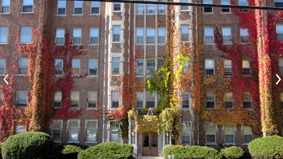 |
|
»700 Stewart Avenue, Belleayre
Apartments Source: Ad realtor.com, 2017 |
1955
(From mid-July) 808 Hanshaw Road, Ithaca, New York (home of Professor Fisher).
_MIN.jpg) |
|
»808 Hanshaw Road Photo: ©DEZ 1997 |
(August 26) Finishes Pnin. Lolita, finished in December 1953, has not yet been published.
(September 15) Publication of Lolita by Olympia Press, Paris.
1956
(From February) 'Continental Hotel Apartments', no.10, 16 Chauncy Street, Cambridge, Massachusetts.
(Spring) Motoring 10,000 miles in their "good old frog-green Buick" to Utah (a ranchito at Mt. Carmel), Arizona and Montana.
(From July 1) 425 Hanshaw Road, Ithaca, New York.
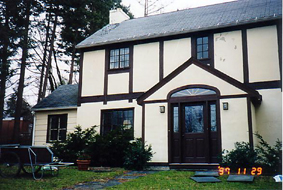 |
|
»425
Hanshaw Road Photo: ©Akiko Nakata 1997 |
1957
(From February 3) 880 Highland Road, Ithaca, New York (home of L. Sharp). Nabokov's favorite Ithaca home.
(March 7) Publication of Pnin.
1958
(From February 23?) 404 Highland Road, Ithaca, New York.
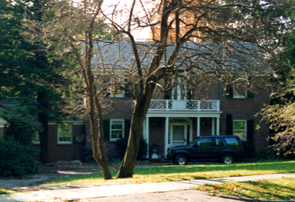 |
|
»404 Highland Road Photo: ©DEZ 1997 |
(July 21) Publication of first American edition of Lolita, by G.P. Putnam's Sons, New York.
(September 18) Publication of Nabokov's Dozen, a collection of thirteen stories.
1959
February 24) Leaving Ithaca, by car via Schenectady to New York City.
(February 26–April 18) Hotel Windermere, 666 West End Avenue, New York.
(April 18) By car to Arizona, via Tennessee (Great Smokies), Alabama and Big Bend, Texas.
(Early summer) At summer cabins resort Forest Houses between Flagstaff and Sedona, Arizona, hunting butterflies in Oak Creek Canyon; visit by journalist/writer Robert H. Boyle who accompanies him on an unsuccessful day hunt.
_MIN.jpg) |
|
»Resort Forest Houses near Sedona, Arizona Source: TripAdvisor |
(July 20) From Sedona to Los Angeles, California.
(July 20–end of July) The Beverly Hills Hotel, 9641 Sunset Boulevard, Beverly Hills, California
(End of July to mid-August) Brockway Hotel on North Lake Tahoe, California.
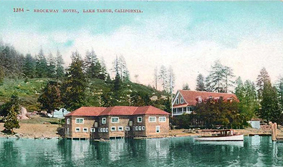 |
|
»Brockway
Hotel, North Lake Tahoe,
California PPC |
(Early September) Park Crescent Hotel, 87th and Riverside Drive, New York City.
(September 29–October 5) On the CGT liner S.S. 'Liberté' from New York City to Le Havre, intending to spend a few days in Paris. Not finding any accomodation because of the ongoing Salon d'Auto, they take the night train to Geneva.
_MIN.jpg) |
| »S.S. 'Liberté' |
(October 6–20?) Geneva, Hotel Beau Rivage, mainly to visit with his sister Elena Sikorski who is working as an interpreter for the UN.
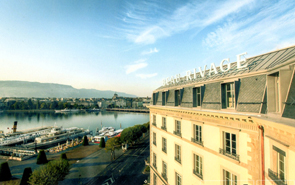 |
|
»Hotel Beau Rivage, Geneva Source: TripAdvisor |
(October 21–28) Paris, Hotel Continental (Today: InterContinental Paris Le Grand Hotel), Place de l'Opéra, for a hectic week surrounded by crowds of publishers, agents, interviewers, photographers, admirers who want to see the author of Lolita.
(October 23) Gala party with 2,000 guests at Gallimard's, no. 5, rue Sebastien-Bottin [today rue Gaston Gallimard]), to celebrate the publication of Lolita in French. Confused by the crowd and the fuss, Nabokov does not notice Maurice Girodias (the first publisher of Lolita he had been quarreling with for three years) and his former warm friend Zinaida Shakhovskoy he had known in Brussels before WWII and who takes this as snub and later writes an article and a book to vent her ill feelings.
(October 28) From Paris via Dover to London (Stafford Hotel, St. James's Place, Westminster) for the British publication of Lolita. After much press coverage, his publishers Nigel Nicolson and Lord Weidenfeld are still unsure if the government will ban the novel and persecute them.
(November 4) To Cambridge, for a talk on Russian Classics, Censors and Readers.
(November 5) Party with several hundred guests at The Ritz Hotel in London (150, Piccadilly Square) to celebrate the publication of Lolita which the government has just declared it would not ban.
(November 6) Traveling to Rome for a ten-day stay, Grand Hotel di Roma (today The St. Regis, 3, Via Vittorio Emanuele Orlando).
_HotelWWWPubl_MIN.jpg) |
|
»St. Regis Grand Hotel
di Roma Source: Hotel Web Publicity |
(Around November 10) Party to celebrate the Italian publication of Lolita by Mondadori.
(Mid-November) Traveling from Rome to Taormina, Grand Hotel; for the first time envisaging to turn Lolita into a screenplay for Stanley Kubrick.
(November 27) From Sicily to Genoa, Colombia Excelsior Hotel (Il Grand Hôtel Colombia di Genova, between main station and Stazione Marittima, closed 1989); begins writing Ada, at that time called Letters to Terra.
(December 9) To Lugano, Grand Hotel, room 317–318.
(December 13) By taxi to Milano, Hotel Principe di Savoia (Piazza della Repubblica, 17).
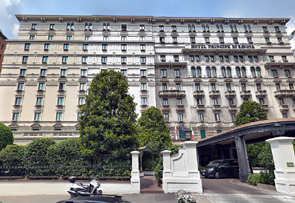 |
|
»Hotel Principe di Savoia,
Milano Source: Google Street View 2014 |
(December
25) By car to San Remo, Hotel Excelsior-Bellevue,
for a Christmas meeting with
Dmitri, his sister Elena, her son Vladimir
and his youngest brother Kirill.
1960
(Early January to February) To Hôtel Astoria, 17 Avenue Carnot, Menton.
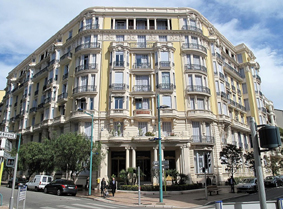 |
|
»Hôtel Astoria, Menton
(Alpes-Maritimes) Source: Wikimedia Commons, 2010 |
(February 18) By train from Menton to Le Havre.
(February 19) On the S.S. 'United States' (United States Lines) from Le Havre to New York.
_MIN.jpg) |
| »The S.S." 'United States' |
(February 27) By train via Chicago to Los Angeles. Lodging at one of the "bungalows" of the Beverly Hills Hotel on Sunset Boulevard and meeting with Stanley Kubrick at the Universal City Studios to discuss the forthcoming "cinemization" of Lolita.
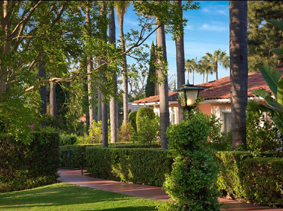 |
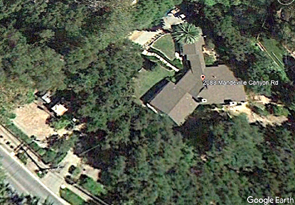 |
|
»A bungalow of the Beverly
Hills Hotel Source: booking.com |
»2088
Mandeville Canyon Road, Los Angeles as seen by Google Satellite in 2012 |
(March 10 to October 12) Living in a villa rented for him by the film company in Brentwood Heights, 2088 Mandeville Canyon Road, Los Angeles, writing the screenplay for Stanley Kubrick's Lolita. Today the large house is hidden by thick greenery.
(Late June/early July) Butterfly excursion to Glacier Lodge, Inyo County, California.
(October 12–15) By train via Chicago to New York.
(October 15–November 2) At Hampshire House (room 503), 150 Central Park South, New York City. Hampshire House was a 37-floor tower built in 1939 exactly in the center of the southern rim of Central Park, with up to 206 apartments and hotel facilities. This is where for three decades Luciano Pavarotti had his $10.5M Manhattan pied-à-terre. Nabokov stayed at least twice in 1962 and 1964 for a few days and obviously was impressed.
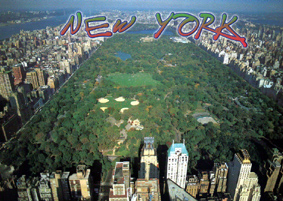 |
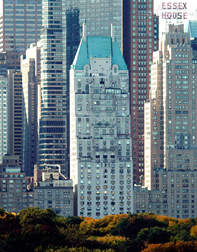 |
|
»View from
Central Park South towards the north of Manhattan PPC |
»Hampshire
House Source: CityRealty |
(November 2–7) On the Cunard ocean liner RMS 'Queen Elizabeth' from New York to Cherbourg.
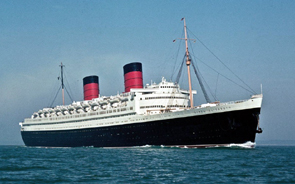 |
| »RMS 'Queen Elizabeth' PPC |
(November 7-9) Via Paris to Milano, Hotel Principe di Savoia.
(November 26) To Nice, Hotel Negresco, 37, promenade des Anglais, looking for an appartment.
(November 29) Begins the writing of Pale Fire: John Shade's poem.
(Early December to April 7, 1961) Nabokov's new European address now is 57, promenade des Anglais (appartement no. 3), Nice (Alpes-Maritimes).
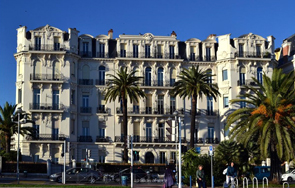 |
|
»57, Promenade des Anglais,
Nice Source: www.facades-de-nice.fr |
1961
(April 26) By car to Reggio Emilia (for Dmitri's operatic debut in La Bohème, along with Luciano Pavarotti).
(May 8) By car to Stresa.
(early June) To Milano for a concert by Dmitri.
(mid June) By car via Martigny to Champex-Lac (Valais).
(June 15 to August 15) Champex-Lac (Valais), Grand Hôtel des Alpes (working on Pale Fire, hunting butterflies at Verbier, Crans, Simplon and Saas-Fee).
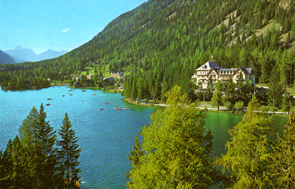 |
|
»Grand Hôtel des Alpes,
Champex-Lac, Valais PPC |
(End of July to August 7) To Simplon Kulm (Vaud), Hotel Bellevue.
(August 7)
To Montreux (Vaud), Hotel Belmont.
From this hotel, situated above Hotel Montreux Palace, they will have
checked out their future abode where they were to check in
eight weeks
later.
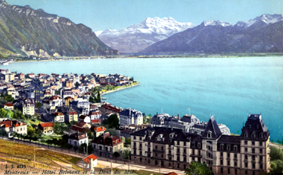 |
|
»Hotel Belmont, Montreux
(Vaud) with southern end of Lake Geneva and the Dents du Midi PPC |
(September 20) By car to Milan (to hear Dmitri sing at the Scala).
(October 1 until July 2, 1977, Véra until late in 1989 when she had to leave the hotel because of impending renovations) Vladimir and Véra Nabokov rent a suite at the Hôtel Montreux Palace in Montreux (Vaud), 2 avenue Claude Nobs, today Fairmont Le Montreux Palace, a luxurious Belle Époque lakeside hotel built in 1906. Their eight rooms were in the offset old part of the hotel, the former Hôtel du Cygne, built in 1837, to the right of the main hotel as seen from the lake, on the third floor (no. 35–38). On September 15, 1962 they moved into smaller quarters on the uppermost sixth floor, originally two fused furnished three-room apartments.Their suite consisted according to Brian Boyd (VNAY, p.458) of a living-dining room, VN's bedroom and study, Véra's bedroom, a former kitchenette full of papers, two and a half bathrooms, a room formerly reserved for Dmitri turned into the secretary's office and a back room housing VN's published books.
_MIN.jpg) |
_MIN.jpg) |
|
»Hotel Montreux Palace Photo: ©DEZ 2010 |
»Nabokov's suite
on the
uppermost floor of the old "Cygne" Wing Photo: ©DEZ 2010 |
(December 4) Finishes Pale Fire.
1962
(Before April 11) In Zermatt for the filming of the BBC "Bookstand" TV interview with Peter Duval Smith, Nabokov reading his prepared answers with the Matterhorn looming large behind him.
(April 25) Publication of Pale Fire.
(May 31 to June 5) On Cunard liner RMS 'Queen Elizabeth' from Cherbourg to New York for the gala premiere of Kubrick's Lolita on June 13.
(June 5–20) Staying at St. Regis Hotel, Fifth Avenue, New York
(June 20) On the RMS 'Queen Elizabeth' back from New York to France.
(June 26) Back at his hotel suite in Montreux.
(July 1) To Saas Fee (Valais) which Nabokov disliked so the next day he moved on to Zermatt (Valais), Hotel Mont Cervin Palace, Bahnhofstrasse 31. Here Horst Tappe shot the famous photos of Nabokov on a mountain path with a black wet hooded parka.
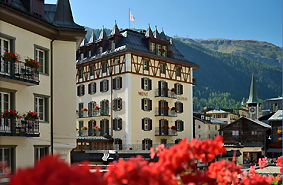 |
|
»Hotel Mont Cervin
Palace,
Zermatt (Valais) Source: www.google.de/maps 2018 |
(September 15) VN and Véra move from the third floor to a smaller suite on the sixth floor of the "Cygne" wing of the Montreux Palace.
1963
(May 27) By car (Peugeot) to Loèche-les-Bains (Leukerbad), Valais, Hotel Bristol.
(Mid-July) By car to Les Diablerets (Vaud), Grand Hotel.
(August 19) By car back to Montreux.
1964
(March 17) Leaving Montreux and crossing the Atlantic on the S.S. 'United States' for the launching of Pushkin Eugene Onegin.
(End of March) Again at Hampshire House in New York City, then by train to Ithaca, New York.
(April 2) Flying back to New York City.
(April 9) To Cambridge, Massachusetts.
(April 10) Last public reading at Harvard College Library, Woodberry Poetry Room (poems, excerpts from Pale Fire and Lolita). The reading was recorded.
(mid April) Back to New York City.
(April 21) Bollingen Press reception in honor of Pushkin Eugene Onegin.
(April 23) On SS 'United States' back to Europe.
(June 22) Publication of Pushkin Eugene Onegin.
(end of December) In Abano Terme (Padua), Hotel Due Torri.
1965
(Late April) Grand Hotel, Gardone Riviera (Brescia) on Lake Garda. Preliminary work on Ada: The Texture of Time.
_MIN.jpg) |
|
»Grand Hotel, Gardone Riviera
(Brescia) PPC |
(July) Suvretta House, St. Moritz (Grisons).
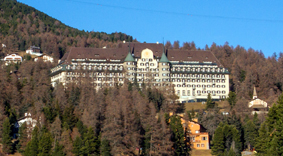 |
|
»Suvretta House, St.
Moritz (Grisons) Source: Wikipedia 2012 |
(August 10) Back at his hotel suite in Montreux.
1966
(Mid-February) Has the inspiration that starts the actual writing of Ada.
(Mid-April) Off on their tour to Italy, to hunt butterflies and to see art collections (for the Butterflies in Art project and for Ada).
(Mid-April) Staying in Monza with Dmitri for a few days.
(Late April) Bologna, to visit the art gallery.
(Late April) In Florence for two weeks, visiting more than a dozen galleries.
(Early May) Two days at Pompei where they were denied to see the erotic frescoes in the Lupanare.
(May 7 to c. May 20) Albergo Cappucino Convento, Amalfi (Salerno).
(Around May 20 to May 24) Naples, visiting the Museo Nazionale (seeing the fresco La Primavera from Stabiae).
(Last week of May to end of June) Grand Hotel Excelsior, Chianciano Terme (Siena). Nabokov liked it; good hunting in Tuscany, but summer getting too hot.
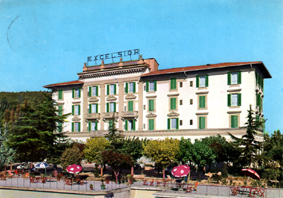 |
|
»Grand Hotel Excelsior,
Chianciano Terme (Siena) PPC c.1960 |
(From end of June to August) Il Grande Albergo (formerly: ...della Cassa di Resparmio), Ponte di Legno (Brescia), at that time not even a ski resort but a tiny Alpine village with one big hotel, on the way from Brescia and the northern tip of Lake Garda to Madonna di Campiglio (Trento). Cool and rainy, hardly an opportunity for butterfly hunting.
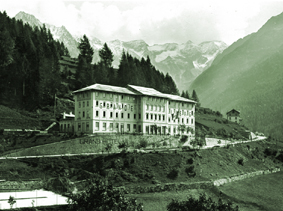 |
|
»Il Grande Albergo,
Ponte di Legno (Brescia) PPC c.1933 |
1967
(January 9) Publication of a revised and expanded version of Speak, Memory.
(April 4 to June 13) At Hotel Cenobio dei Dogi, Camogli (Genoa).
(July) At CITA Grand Hotel (today Grand Hotel Principe), Limone Piemonte (Cuneo).
1968
(Late March) Véra brings friend and cousin Anna (Anyuta) Feigin whose health had been deteriorating over from New York City to Montreux, sets her up in an apartment there and nurses her until her death in 1972.
(April 17, for a week) At Cernobbio on Lake Como (Como, Lombardy).
(From May 10 to early July) Hôtel des Salines, Bex-les-Bains (Vaud).
(from early July to early August) Parc Hotel, Verbier (Valais).
(October 16): Finishes Ada.
1969
(April 2) Publication of Ada or Ardour: A Family Chronicle.
(June 20) To Lugano (Ticino), Switzerland, Hotel Splendide Royal.
(July) In a rented house at Cureglia near Lugano (Ticino).
(First three weeks of August) In Adelboden (Bern).
(August 22) Back to Montreux.
1970
(March 19) To Rome.
(From April 5) By train and ferry to Taormina (Messina), San Domenico Palace Hotel, room 220 ("the hotel is charming"), Véra arriving on April 15. Taormina is in the NE of Sicily's Ionian Coast, about 40 km N of Mount Etna and at an elevation of 250 m.
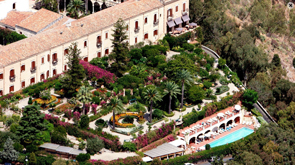 |
|
»Hotel San Domenico
Palace, Taormina Source: Hotel Web publicity |
(Mid-May) Back to Montreux.
(Last week of June) By car to Saas Fee (Valais), Grand Hotel.
(Late July) Back to Montreux.
1971
(March 24) Flying (for the first time in life) from Geneva to Lisbon, Portugal; staying at the Hotel Ritz (Rua Rodrigo da Fonseca 88) until March 30.
(March 30 to April 14) To Praia da Rocha, Algarve Hotel (the weather too cold and windy for butterfly hunting).
(End of April) Flying back to Montreux earlier than planned.
(May) Flying to Nice and on to Tourtour near Draguignan (Var). Véra falls ill, and they return to Montreux.
VN is driven on his own to Anzère-sur-Sion (Valais), Hôtel des Masques, to hunt butterflies.
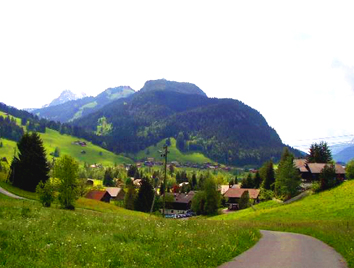 |
| Chalets at Wyssmülleri between the towns of
Saanen and Gstaad, canton of Berne Source: TripAdvisor 2007 |
(August) VN and Véra rent three apartments in a chalet-like lodge between Saanen and Gstaad at a locality called Wyssmülleri (canton of Berne), perhaps on Wyssmülleriweg. Brian Boyd has "Residence Wyssmüllerei" (VNAY, p.585) but it is not clear whether this was the actual name of the lodge or an English designation. One apartment was for themselves and Dmitri, one for Anna Feigin, one for sister Hélène Sikorski and Véra's sister Sonia Slonim. "Dreary region. Wretched butterfly hunting". He may have changed his opinion on the butterfly grounds of Saanen after he caught the first of three Sooty Coppers (Lycaena tityrus) on August 2, 1971.
Begins in earnest to compose his novel Transparent Things.
(November 23) Resumes work on Transparent Things after a four-months pause.
1972
(January 6) Véra Nabokov's cousin and friend Anna (Anyuta) Feigin dies in Montreux.
(April 1) Finishes Transparent Things.
By train to Amélie-les-Bains (Pyrénées-Orientales) for a short rest.
(June 19 for a month) Lenzerheide (Grisons).
(August) Again in the "Résidence Wyssmülleri" in Saanen (Bern), like in August, 1971, with Dmitri, Anna Feigin and Hélène Sikorski.
(October 13) Publication of Transparent Things.
1973
(February to July) Begins composing his last novel Look at the Harlequins!) in Montreux, Cervia (Ravenna) and Cortina d'Ampezzo (Belluno).
(April 10) Publication of his story collection A Russian Beauty.
Publication of Strong Opinions.
(Early June) By taxi to Cervia, south of Ravenna, on the Adriatic Coast, staying three weeks.
(Late June to August 3) In Cortina d'Ampezzo, southern Dolomitic Alps.
(September) Resumes work on Look at the Harlequins!
1974
(February 25) Publication of Lolita: A Screenplay.
(April 3) Finishes Look at the Harlequins!
(July) Zermatt (Valais), Hotel Mt. Cervin Palace.
(5 days at the end of July) At Sarnico on Lago d'Iseo in a house Dmitri had been lent by friends.
(August 27) Publication of Nabokov's last finished novel Look at the Harlequins!.
1975
(January 27) Publication of his story collection Tyrants Destroyed.
(End of May) To Paris for his only live (though carefully prepared) tv interview with Bernard Pivot for his series Apostrophes on Antenne-2 (day of broadcast May 30).
(June 5 to 19) With Véra to the resort town of Davos (Grisons), to rest and to hunt butterflies, staying at Hotel Flüela (today Rixos Flüela), Bahnhofstrasse 5, close to the railway station and the bottom station of the Jakobshorn cablecar.
_MIN.jpg) |
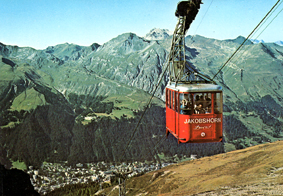 |
|
»Hotel Flüela, Davos (Grisons) PPC |
»Davos
from the Jakobshorn cablecar PPC before 2014 |
(July 13) Slips twice on a steep slope (possibly beneath the wooded lower section of the Jakobshorn cablecar) during one of his butterfly hikes, tumbling 150 feet. Though no bones are broken, he is unable to get up. The cablecar operator notices beckoning but thinks he is jesting. When after two and a half hours he realizes he is in distress, they carry VN down on a stretcher. He has to rest in bed for some days. The accident marks the beginning of his physical decline.
(August 3) Back to Montreux.
(Early September) To Montreux Hospital for a urographic examination. The diagnosis is a tumor on the prostate.
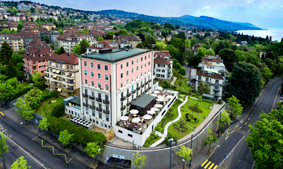 |
|
»Clinique de Montchoisi, Lausanne Source: Monikasobolewska/Creative Commons 3.0 |
(October 15) To the Clinique de Montchoisi in Lausanne, for an operation of the tumor that turns out to be benign. Returns home after two weeks, but with an infection of sorts (hospital-induced?) and insomnia worse than ever.
1976
(March 9) Publication of his last collection of stories, Details of a Sunset.
(April 24) Nocturnal panic attack.
(May 1? to May 10?) Falls in his bathroom and with a concussion is taken by ambulance to the CHUV (Centre Hospitalier Universitaire Vaudois), Lausanne, rue du Bugnon 46.
(June 17) Again to the Clinique de Montchoisi, Lausanne, because of persistent temperatures; partly semi-conscious. Diagnosis of too low sodium and potassium levels and an infection of the urinary tract.
_MIN.jpg) |
|
»Entrance
to Hôpital Nestlé, Lausanne Source: Wikimedia Commons |
(July 9) Transferred to the Hôpital Nestlé in the vast CHUV medical complex, c. 1570 beds. (The Hôpital Nestlé's specialty is neuropsychology and neurorehabilitation.)
(September 7) Discharge from the Nestlé Hospital.
(September) Two weeks of convalescence at the Clinique Valmont in Glion sur Montreux (Vaud), just above Montreux.
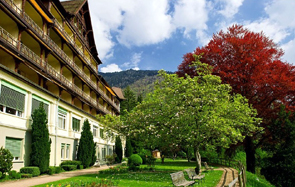 |
|
»Clinique Valmont, Glion
sur Montreux Source: swissspital |
(September 21) Return home.
1977
(March 19) By ambulance back to the Nestlé Hospital in Lausanne with a high fever.
(May 7) Discharged and return home, but still feverish.
(June 5) Back to the CHUV in Lausanne, getting ever weaker.
(June 30) Moved to intensive care within the CHUV.
(July 2, 6:50 pm) Dies from congestive bronchitis.
(July 7) Nabokov's body cremated in Vevey.
(July 8) Nabokov's ashes interred in the cemetery of Clarens (on a hill between Vevey and Montreux).
%20MIN.jpg)
|
|
»Nabokov's grave in the
cementary of Clarens Photo: ©DEZ 2010 |
_MIN.jpg)
_MIN.jpg)
_MIN.jpg)
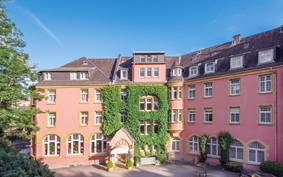
_MIN.jpg)
